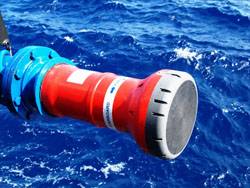Sonardyne’s Calibration-Free Acoustic Positioning Delivers Client Savings
Sonardyne’s Calibration-Free Acoustic Positioning Delivers Major Savings for CSA International.
CSA International Inc, an environmental survey company working in the Gulf of Mexico, has become the first organisation in the world to purchase a new, ‘calibration-free’ acoustic positioning system launched by Sonardyne International Ltd. The GyroUSBL integrates Sonardyne’s Lodestar Attitude and Heading Reference System (AHRS) and sixth generation (6G®) Ultra-Short BaseLine (USBL) transceiver into a single unit and was shown to offer significant operational benefits during a deep water ROV survey carried out this summer.
Most USBL positioning systems need to undergo a calibration process to determine the precise alignment offsets between the acoustic transceiver and the vessel’s own attitude sensors. This is often a time consuming exercise involving the vessel undertaking specific manoeuvres over several hours whilst all the necessary data is collected and then processed.
With Lodestar GyroUSBL, any sensor offsets have largely been removed by the tight mechanical coupling of the survey-grade AHRS unit and the USBL array during its assembly and calibration at Sonardyne’s factory. This integration also enables the attitude sensor data latencies associated with conventional USBL set-ups, to be virtually eliminated, further improving precision and accuracy. Lodestar GyroUSBL can therefore be deployed on any vessel and put to work very quickly without users first having to perform a calibration.
The Lodestar GyroUSBL was supplied to CSA as part of a Sonardyne Ranger 2 positioning system and was installed on an over-the-side deployment pole fitted to the offshore supply vessel ‘HOS Sweetwater’. During the survey, the Lodestar GyroUSBL was put to the test tracking an ROV as it descended to 1,478 metres. Out-of-the-box, the factory calibration produced a slant range accuracy result of 4.25m (0.3%). For many projects, this performance would meet positioning specification however it was decided that a single calibration would be run to make a fine determination of the pitch roll alignment errors. This further improved the slant range accuracy to 1.9 metres, or just 0.13% of water depth.
Because of their versatility, USBL systems are routinely moved from vessel-to-vessel to support a wide range of subsea tasks. As soon as this happens, then the relationship between USBL transceiver and the attitude sensors is lost. The only way to re-establish the relationship is to re-calibrate the system on the new vessel. As the Lodestar GyroUSBL is a combined unit, the precise alignment is carried within the unit meaning that when installed on a new vessel, a repeat calibration is not required. A simple ‘spin-test’, which can be performed on-route to the vessel’s work location, is all that is now advised to verify the GPS antenna offsets for the new installation.
Eddie Walsh, CSA Operations Supervisor, said, “The performance of the entire Ranger 2 system was very impressive. In addition to the pre-calibrated Lodestar GyroUSBL, we were able to track the ROV at a 1Hz update while simultaneously tracking three individual transponders using different tracking scenarios.” He added, “The through-life savings in vessel day rates due to the elimination of repeated calibrations will ensure that the Lodestar GyroUSBL will pay for itself very quickly. In the future, when we install the system on a different vessel, we can begin work with minimal vessel delays.” www.sonardyne.com.












